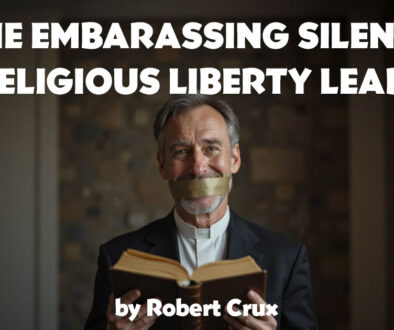Our Controversy Over The Great Controversy, Part 2: Modernism’s Pledge to Reason
by Jim Walters | 3 July 2024 |
Given the prominence of the theme of The Great Controversy (TGC) in Adventism, and how conditions have changed in society and in the church over the last 165 years, it’s reasonable to use the modernist tool of reason to examine the TGC’s relevance to present circumstances.
Reason “a gift of God”
Reason characterizes modern life in the so-called western world—Europe, North America and Australia/New Zealand. In contrast to the pre-modernism of the church of our pioneers, all of these have come of age under the domination of the post-Enlightenment scientific age.
But reason—the power of the mind to think—isn’t new to Judeo-Christian culture. Scripture says, “Come now, let us reason together, says the Lord” (Isa. 1:18). Paul repeatedly reasons with his hearers in the synagogues. “He…for three Sabbaths reasoned with them from the Scriptures” (Acts: 17:1-3; cf. 18:4; 18:19). His address to the scholars on Mars Hill (Acts 17:22-31) is regarded as a masterpiece of reason to an agnostic crowd.
Implicit in the Adventist notion of present truth is the affirmation of needing to reason about Scripture and contemporary life to ascertain the Spirit’s current work. How else is the Adventist believer to distinguish between old ideas of truth, and the truths God wants emphasized at present? Ellen White calls reason a “gift of God” (CT 423).
Thus, a reasoned examination of TGC might start with this observation:
- When Ellen White had her 1858 TGC vision, the unorganized Sabbatarian adventists numbered less than 3,000—half the size of some current Adventist churches. These believers dwelt in a very Christian nation where Sunday laws were a present threat.
- Today, our organized church of 22+ million has fewer than two million members in the increasingly secular western world where Sunday Laws have little meaning, and over 20 million in nations of such religious diversity that Sunday laws are unthreatening, if not entirely irrelevant.
The messenger reexamined
In reasoning about the TGC’s standing today, let us now examine both the person who experienced the TGC vision, and the content of the vision itself.
As a 31-year-old at the time of her initial TGC vision, Ellen White seems to have had a commanding presence. She was a bright young person who’d been converted to Millerism, along with the rest of the Harmon family, from a “shouting Methodist” congregation. As a 12-year old at a William Miller preaching service, she’d gone forward for special prayer at the “anxious seat” in an 1840 church meeting that was likely characterized by “deep emotionalism and ecstatic display.”[1] Only months after the Great Disappointment, she and several other known visionaries participated in a prayer meeting in Israel Dammon’s house, leading to his apprehension for disturbing the peace.[2]
Three years later Ellen and James White participated in the Sabbath Conferences, at which the little group’s basic doctrines were debated, with Ellen—a self-acknowledged scriptural light-weight—mainly contributing prophetic reconciliation. She continued to have visions which were published in husband James’ Present Truth (1849-1850).
Due to accusations of fanaticism and basing doctrines on visions rather than Scripture, James then refused to publish his wife’s visions for the next five years of the Advent Review and Sabbath Herald (1850–1855).
The TGC vision occurred but three years after the 1855 Adventist laity began to clamor for Ellen’s visions again to be published, which was done under newly appointed editor Uriah Smith.
The vision reexamined
Ellen White’s special TGC vision occurred when she was attending a funeral service that husband James conducted in Ohio on March 14, 1858. The two-hour vision resulted in a 224-page book within about five months—despite what Ellen described as an initial attack by Satan to thwart her writing, involving loss of speech and a feeling that she did “not expect to live.”
Not long after this vision, she shared an oral account of the TGC vision in Battle Creek, which was heard by J.N. Andrews. Andrews noticed similarities with John Milton’s Paradise Lost. As recounted by grandson Arthur White, Andrews asked her,
“‘Have you ever read Paradise Lost?’ She said, ‘No.’” Thinking she’d be interested, a few days later he brought her a copy. Arthur White writes: “[S]he took the book, hardly knowing just what to do with it, looked at it, but didn’t open it…[and] put it on a high shelf, determined that if there was anything in that book similar to what God had revealed to her in vision she was not going to read it until she had first written out what the Lord had revealed to her.”
Over the years Ellen White scholars both friendly and unfriendly have noted the similarities between Paradise Lost and TGC, and the White Estate has acknowledged limited parallels. The Estate admits that
“when working on Patriarchs and Prophets, Mrs. White might have used some of the phraseology of Paradise Lost….[but] if so…it was well within the acceptable standards of her day.”
So I was not prepared for what I learned last year from established Ellen White scholar Denis Fortin from the Adventist Theological Seminary at Andrews University. Fortin reported in October 2023 to a group of Adventist scholars meeting at Pacific Union College that several years ago he was at home comparing the text of Ellen White’s written account of her TGC vision with John Milton’s Paradise Lost. He was totally unprepared for what he discovered: that 80-90% of Ellen White’s account of her TGC vision is directly dependent on Paradise Lost. He said he was “shaken to the core.”
Church historian George Knight, in a Pacific Union College presentation, acknowledges the “messy” characters of some Bible prophets and kings, and likewise admitted that Ellen White was not “squeaky clean.” In private I pressed him: Would his biblical model of inspiration even allow for Ellen to deceive J.N. Andrews about her reliance on Paradise Lost? Knight responded: If King David could murder a man, Ellen White could be deceptive about her authorship of the TGC account. (Knight gave me permission to share this personal interchange, adding that if Ron Numbers hadn’t written in the shadow of a “perfect prophet” model, Ron’s research may have had a different slant.)
At the Pacific Union College conference two models emerged for dealing with Ellen White’s humanity: the fraud model and the empathy model.
Steve Daily’s Ellen G. White: A Psychobiography is surely in the first category, and perhaps Donald Casebolt’s Father Miller’s Daughter and Child of the Apocalypse as well. These writers describe Ellen White as deceptive—at least in Daily’s case, intentionally.
Another set of scholars deal with identical material, but make an effort to view circumstances from the subject’s viewpoint, while also recognizing and accepting their own critical perspective. Here I’d see the scholars Eric Anderson, Terrie Aamodt, George Knight, and Jonathan Butler.
Reason’s inadequacy
Some students of Adventism, particularly those utilizing the modernist approach, abandon Adventism when they see the disparity between official Adventist claims and their reasoned concept of truth. They have concluded, intuitively if not consciously, that following reason and remaining Adventist are incompatible. This is understandable, and to be respected. In his recently published The Dance of the Big Hunger, esteemed churchman Smuts van Rooyen confesses that he’s “considered leaving due to spiritual claustrophobia, but I choose to remain.” He adds,
“Others, whom I admire and respect, have adequately exposed the doctrinal fallacies of the church and then departed. God, I know, had led them to go, as He has led me to stay.”[3]
But reason in and of itself isn’t a full answer. Reason is a neocortical tool that, when it kicks in, is capable of being used to give support to our own desires. It appears to be dispassionate, but it draws on needs rooted deep in our visceral selves. Immanuel Kant, as brilliant as he was, didn’t realize this now-widespread perspective on reason: Kant worshiped “capital-R” Reason to the extent that he gives an illustration of how Reason dictates against a white lie even if it would thwart a wanton murderer.
But we get ahead of ourselves. The final installment of this series concerns a topic that tops raw reason: human meaning. This is the domain of postmodern thought—and here, the TGC metaphor is surprisingly relevant.
- Theodore N. Levterov, Accepting Ellen White: Early Seventh-day Adventists and the Gift of Prophecy Dilemma (Nampa, ID: Pacific Press Publishing Association, 2016), p. 13. ↑
- “The Arrest of Israel Dammon,” http://www.1timothy4-13.com/files/bible/sda_dammon.html ↑
- Smuts van Rooyen, The Dance of the Big Hunger (Westlake Village, CA: Oak and Acorn Publishing), xv. ↑
 James W. Walters is professor emeritus of ethics at Loma Linda University.
James W. Walters is professor emeritus of ethics at Loma Linda University.




